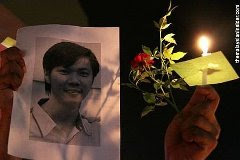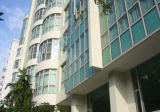The Commerce Department said on Friday its first estimate put fourth-quarter gross domestic product growth at its fastest pace since the third quarter of 2003. The economy expanded at a 2.2 percent annual rate in the third quarter.
Analysts polled by Reuters had forecast GDP, which measures total goods and services output within U.S. borders, growing at a 4.6 percent rate in October-December period.
"Wow, great number. It's very solid and gives us a running start into the second half of the year when we can't rely on government stimulus," said Jack Ablin, chief investment officer at Harris Private Bank in Chicago.
"That's part of the plan, to get us moving as fast as possible so when life support is removed we'll have a pulse."
U.S. stock index futures extended gains on the data, while Treasury debt prices deepened losses. U.S. dollar rose against the yen.
Getting the economy on a sustainable growth track remains one of the key challenges facing President Barack Obama, who on Wednesday outlined a raft of measures to create jobs and nurture the recovery.
Growth was boosted a sharp slowdown in the pace of inventory liquidation, a factor that could mask the strength of the economic recovery from the longest and deepest downturn since the Great Depression.
But even stripping out inventories, the economy expanded at an annual rate of 2.2 percent, accelerating from the 1.5 percent increase in the third quarter, reflecting relatively strong performance from other segments of the economy.
Business inventories fell only $33.5 billion in fourth quarter after dropping $139.2 billion in the July-September period. The change in inventories alone added 3.39 percentage points to GDP in the last quarter. This was the biggest percentage contribution since the fourth quarter of 1987.
For the whole of 2009, the economy contracted 2.4 percent, the biggest decline since 1946, the first year after the end of World War II.
In the last three months of 2009, consumer spending increased at a 2 percent annual rate, below the 2.8 percent annual pace in the prior quarter when consumption got a boost from the government's "cash for clunkers" program.
In the fourth quarter, consumer spending contributed 1.44 percentage points to GDP.
Consumer spending, which normally accounts for about 70 percent of U.S. economic activity, has been held back by the worst labor market in a quarter century.
Business investment in the fourth quarter grew for the first time since the second quarter of 2008 as the drag from the troubled commercial real estate was offset by robust spending on equipment and software.
The growth of spending on new home construction braked sharply in the fourth quarter to an annual rate of 5.7 percent from an 18.9 percent pace in the third quarter. Home building has received a lift from a popular tax credit for first-time buyers, but recent data have hinted at some weakness starting to creep in.
Export growth outpaced imports, leaving a trade gap that contributed half a percentage point to GDP growth in the last quarter.
Separately, employment costs in the United States rose 0.5 percent in the fourth quarter, Labor Department data showed.
Analysts polled by Reuters had expected the Employment Cost Index to increase 0.4 percent in the three months ending in December 2009, after it inched up an unrevised 0.4 percent in the prior quarter.
Wages and salaries, which make up about 70 percent of compensation, and benefits were both up 0.5 percent, the Labor= Department said.
Also, business activity in New York City expanded in January for the sixth straight month, reaching its highest level in over three years, according to an industry report released on Friday.The Institute for Supply Management-New York's seasonally adjusted index of current business conditions rose to 72.6 in January from an upwardly revised 64.5 in December, originally reported as 59.7.
It was the group's highest current conditions reading since November 2006.





